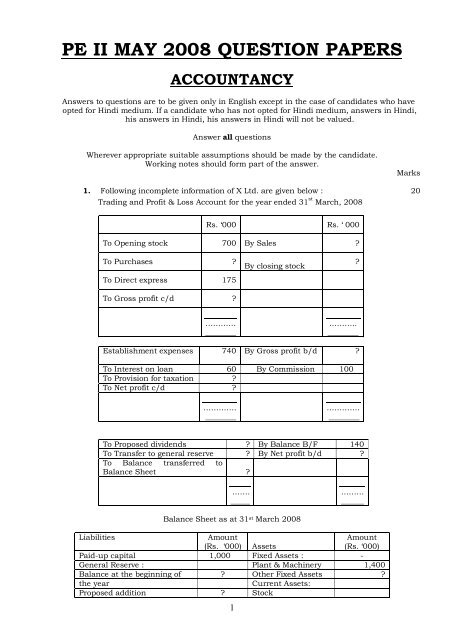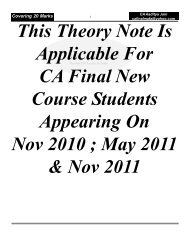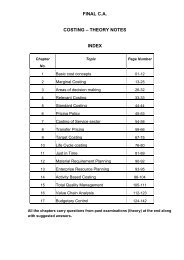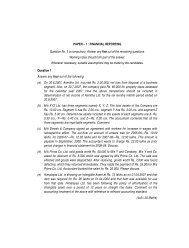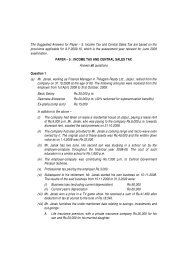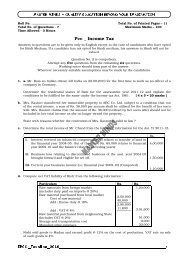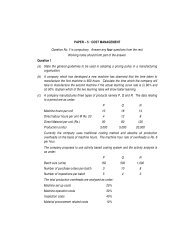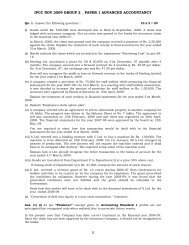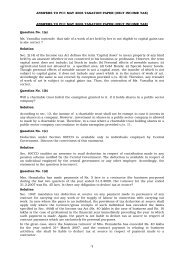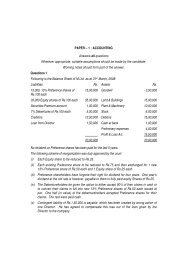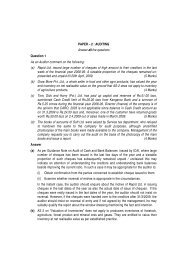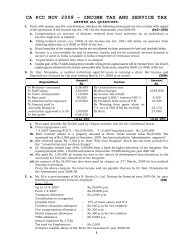pe ii may 2008 question papers accountancy - Master Minds
pe ii may 2008 question papers accountancy - Master Minds
pe ii may 2008 question papers accountancy - Master Minds
You also want an ePaper? Increase the reach of your titles
YUMPU automatically turns print PDFs into web optimized ePapers that Google loves.
PE II MAY <strong>2008</strong> QUESTION PAPERS<br />
ACCOUNTANCY<br />
Answers to <strong>question</strong>s are to be given only in English except in the case of candidates who have<br />
opted for Hindi medium. If a candidate who has not opted for Hindi medium, answers in Hindi,<br />
his answers in Hindi, his answers in Hindi will not be valued.<br />
Answer all <strong>question</strong>s<br />
Wherever appropriate suitable assumptions should be made by the candidate.<br />
Working notes should form part of the answer.<br />
Marks<br />
1. Following incomplete information of X Ltd. are given below : 20<br />
Trading and Profit & Loss Account for the year ended 31 st March, <strong>2008</strong><br />
Rs. ‘000 Rs. ‘ 000<br />
To O<strong>pe</strong>ning stock 700 By Sales ?<br />
To Purchases ?<br />
To Direct express 175<br />
To Gross profit c/d ?<br />
By closing stock<br />
?<br />
…………<br />
________<br />
………..<br />
________<br />
Establishment ex<strong>pe</strong>nses 740 By Gross profit b/d ?<br />
To Interest on loan 60 By Commission 100<br />
To Provision for taxation ?<br />
To Net profit c/d ?<br />
………….<br />
________<br />
………….<br />
________<br />
To Proposed dividends ? By Balance B/F 140<br />
To Transfer to general reserve ? By Net profit b/d ?<br />
To Balance transferred to<br />
Balance Sheet ?<br />
…….<br />
_____<br />
………<br />
______<br />
Balance Sheet as at 31 st March <strong>2008</strong><br />
Liabilities<br />
Amount<br />
Amount<br />
(Rs. ‘000) Assets<br />
(Rs. ‘000)<br />
Paidup capital 1,000 Fixed Assets : <br />
General Reserve : Plant & Machinery 1,400<br />
Balance at the beginning of ? Other Fixed Assets ?<br />
the year<br />
Current Assets:<br />
Proposed addition ? Stock<br />
1
Profit and Loss account ? Sundry debtors ?<br />
10% Loan account Cash at bank<br />
Current liabilities ? 125<br />
…………….<br />
___________<br />
………………<br />
____________<br />
Other in formations:<br />
i. Current ratio is 2 : 1<br />
<strong>ii</strong>.<br />
Closing stock is 25% of sales.<br />
<strong>ii</strong>i. Proposed dividends to paidup Capital ratio is 2 : 3.<br />
iv.<br />
Gross profit ratio is 60% of turnover.<br />
v. Loan is half of current liabilities.<br />
vi. Transfer to general reserves to proposed dividends ratio is 1 : 1<br />
v<strong>ii</strong>. Profit carried forward is 10% of proposed dividends.<br />
v<strong>ii</strong>i. Provision for taxation is equal to the amount of net profit of the year.<br />
ix.<br />
Balance to credit of general reserve at the beginning of the year is twice the amount transferred<br />
to that account from the current year’s profits.<br />
All working notes should be part of your answer. You are required to complete :<br />
i. Trading and Profit and Loss account for the year ended 31 st March, <strong>2008</strong> and<br />
<strong>ii</strong>.<br />
The Balance Sheet as on that date.<br />
2. The Balance Sheet of A Limited and B Limited as at 31 st March, <strong>2008</strong> are as 16 follows. 16<br />
Liabilities A. L.t.d. B Lt.d. Assets A L.t.d. B Ltd.<br />
Marks<br />
Equity shares<br />
Sundry<br />
assets<br />
of Rs. 10 each 20,00,000 12,00,000 40,000 Equity<br />
30,00, 000 14,00,00<br />
General Reserve 4,00,000 2,20,000 Shares in<br />
Creditors 6,00,000 3,80,000 A.Ltd. 4,00,000<br />
30,00,000<br />
<br />
<br />
18,00,000<br />
<br />
30,00,000<br />
<br />
18,00,000<br />
<br />
A Ltd, absorbed B Ltd. on the basis or intrinsic value of the shares. The purchase consideration is to<br />
be discharged in fully paidup Equity Shares. A sum of Rs.1,00,000 is owed by A Ltd. to B Ltd, also<br />
included in the stock of A Ltd. is Rs.1,20,000 goods supplied by B Ltd, at cost plus 20%.<br />
Give Journal entries in the books of both the companies, if entries are made at intrinsic value. Also<br />
prepare Balance Sheet of A Ltd. after absorption.<br />
3. S and T were carrying on business as equal partners. Their Balance Sheet as on 31 st March,<br />
2007 stood as follows : 16<br />
Liabilities Rs. Rs. Assets Rs.<br />
2
Capital Accounts:<br />
S<br />
T<br />
Creditors<br />
Bank overdraft<br />
Bills payable<br />
6,40,000<br />
6,60,000 13,00,000<br />
3,27,500<br />
1,50,000<br />
62,500<br />
Stock<br />
Debtors<br />
Furniture<br />
Joint life policy<br />
Plant<br />
Building<br />
2,70,000<br />
3,65,000<br />
75,000<br />
47,500<br />
1,72,500<br />
9,10,000<br />
18,40,000 18,40,000<br />
The o<strong>pe</strong>rations of the business was carried on till 30 th September, 2007. S Sand T both withdrew in<br />
equal amounts half the amount of profits made during the current <strong>pe</strong>riod of 6 month after 10% p.a.<br />
had been written off on Building and Plant and 5% p.a written off on furniture. During the current<br />
<strong>pe</strong>riod of 6 months, creditors were reduced by Rs. 50,000, Bills payables by Rs. 11,500 and Bank<br />
Overdraft by Rs. 75,000. The Joint life policy was surrendered for Rs. 47,500 on 30 th September,<br />
2007. Stock was valued at Rs. 3,17,000 and debtors at Rs. 3,25,000 on 30 th September, 2007. The<br />
other items remained the same as they were on 31 st March, 2007.<br />
On 30 th September, 2007 the firm sold its business to ST Ltd. The goodwill was estimated at Rs.<br />
5,40,000 and the remaining assets were valued on the basis of the Balance sheet as on 30 th<br />
September, 2007. The ST Ltd. paid the purchase consideration in equity shares of Rs.10 each. You<br />
are required to prepare a Realisation account and Capital accounts of the partners.<br />
4. The Washington branch of XYZ Limited, Mumbai sent the following trial balance as on 31 st<br />
December, 2007 : 16<br />
Head Office A/c<br />
Sales<br />
Debtors and Creditors<br />
Machinery<br />
Cash at Bank<br />
Stock, 1 January, 2007<br />
Goods from H.O<br />
Ex<strong>pe</strong>nses<br />
$ $<br />
<br />
22,800<br />
<br />
84,000<br />
4,800<br />
3,400<br />
24,000<br />
<br />
1,200<br />
<br />
11,200<br />
<br />
64,000<br />
<br />
5,000<br />
<br />
1,10,200 1,10,200<br />
In the banks of head office, the Branch a/c stood as follows:<br />
To Balance b/d<br />
To goods sent to branch<br />
Washington Branch A/c<br />
Rs.<br />
Rs.<br />
8,10,000 By Cash<br />
28,76,000<br />
29,26,000 By Balance c/d<br />
8,60,000<br />
37,36,000 37,36,000<br />
Goods are sent to the branch at cost plus 10% and the branch sell goods at Invoice price plus<br />
25%. Machinery were acquired on 31 st January, 2002, When $ 1.00 = Rs. 40<br />
Rate of Exchange were:<br />
1 st January, 2007 $ 1.00 = Rs. 46<br />
31 st December, 2007 $ 1.00 = Rs. 48<br />
Average $ 1.00 = Rs. 47<br />
Machinery is depreciated @ 10% and the Branch Manager is entitled to a commission of 5 % on the<br />
profit of the branch.<br />
You are required to:<br />
(i)<br />
(<strong>ii</strong>)<br />
Prepare the branch Trading & Profit & Loss A/c in dollars.<br />
Convert the Trial Balance of branch into India currency and prepare Branch Trading & Profit<br />
and Loss A/c and the Branch A/c in the books of head office.<br />
3
5. (a) The following are the figures extracted from the books of New Generation Bank Limited as on<br />
31.3.<strong>2008</strong> : 10<br />
Interest and Discount received Interest<br />
paid on deposits<br />
Issued and Subscribed capital Salaries<br />
and allowances<br />
Directors fee and allowances Rent and<br />
Taxes paid<br />
Postage and telegrams<br />
Statutory reserve fund<br />
Commission, exchange and brokerage<br />
Rent received<br />
Profit on sale of investments<br />
Depreciation on Bank’s pro<strong>pe</strong>rties<br />
Statutory ex<strong>pe</strong>nses<br />
Preliminary ex<strong>pe</strong>nses<br />
Auditor’s fees<br />
Rs.<br />
37,05,738<br />
20,37,452<br />
10,00,000<br />
2,00,000<br />
30,000<br />
90,000<br />
60,286<br />
8,00,000<br />
1,90,000<br />
65,000<br />
2,00,000<br />
30,000<br />
40,000<br />
25,000<br />
5,000<br />
The following further information is given :<br />
(i)<br />
(<strong>ii</strong>)<br />
A customer to whom a sum of Rs. 10 lakhs has been advanced has become insolvent and it<br />
is ex<strong>pe</strong>cted only 50% can be recovered from his estate.<br />
There were also other debts for which a provision of Rs. 1,150,000 was found necessary by<br />
the auditors.<br />
(<strong>ii</strong>i) Rebate on Bills discounted on 31.3.2007 was Rs.12,000 and on 31.3.<strong>2008</strong> was Rs.16,000.<br />
(iv) Provide Rs.6,50,000 for Incometax.<br />
(v)<br />
The Directors desire to declare 10% dividend.<br />
Prepare the Profit and Loss account of New Generation Bank Limited for the year ended 31.3.<strong>2008</strong><br />
and also show, how the Profit and Loss account will ap<strong>pe</strong>ar in the Balance Sheet, if the Profit and<br />
Loss account o<strong>pe</strong>ning balance was Nil as on 31.3.2007.<br />
(b) Prepare the fire Insurance Revenue A/c as <strong>pe</strong>r IRDA regulations for the year ended 31st March,<br />
<strong>2008</strong> from the following details: 6<br />
Claims paid<br />
Legal ex<strong>pe</strong>nses regarding claims<br />
Premiums received<br />
Reinsurance premium paid<br />
Commission<br />
Ex<strong>pe</strong>nses of Management<br />
Provision against unexpired risk on 1 ST April, 2007<br />
Claims unpaid on 1 ST April, 2007<br />
Claims unpaid on 31 ST March, <strong>2008</strong><br />
Rs.<br />
4,90,000<br />
10,000<br />
13,00,000<br />
1,00,000<br />
3,00,000<br />
2,00,000<br />
5,50,000<br />
50,000<br />
80,000<br />
6. Answer any four of the following : 4x4 = 16<br />
(i)<br />
(a) X Ltd. purchased debentures of Rs. 10 lacs of Y Ltd., which are traded in Stock exchange.<br />
How will you show this item as <strong>pe</strong>r AS3 while preparing cash flow statement for the year<br />
ended on 31 ST March, <strong>2008</strong>?<br />
4
(<strong>ii</strong>)<br />
(b) Mr.Raj a relative of key management <strong>pe</strong>rsonnel received remuneration of Rs.2,50,000 for<br />
this services in the company for the <strong>pe</strong>riod from 1.4.2007 to 30.6.2007. On 1.7.2007 he<br />
left the service.<br />
Should the relative be identified as at the closing date i.e., on 31.3.<strong>2008</strong> for the purpose of<br />
AS18?<br />
A manufacturing company purchased shares of another company from Stock exchange on<br />
1st May, 2007 at a cost of Rs.5,00,000. It also purchased Gold of Rs.2,00,000 and Silver of<br />
Rs. 1,50,000 on 1st April, 2005. How will you treat these investments as <strong>pe</strong>r the applicable<br />
As in the books of the company for the year ended on 31st March, <strong>2008</strong>, if the value of these<br />
investments are as follows?<br />
Shares<br />
Gold<br />
Silver<br />
Rs.<br />
2,00,000<br />
4,00,000<br />
2,50,000<br />
(<strong>ii</strong>i) (a) Wye Ltd, received Rs. 50 lacs from the Central Govt. as subsidy for settingup an industry<br />
in backward area. How will you treat it in accounts?<br />
(b) How Govt. great relating to S<strong>pe</strong>cific Fixed Assets is treated in the books as <strong>pe</strong>r As12?<br />
(iv) A Ltd. had 6,00,000 equity shares on April 1, 2007. The company earned a profit of Rs.<br />
15,00,000 during the year 200708. The average fair value <strong>pe</strong>r share during 200708 was Rs.<br />
25. The company has given share option to its employees of 1,00,000 equity shares at option<br />
price of Rs.15. Calculate basic EPS and diluted EPS.<br />
(v) Give names of books required to be maintained in agriculature farm accounting .<br />
(vi) (a) How the Government ex<strong>pe</strong>nditure in India is classified?<br />
(b) In a production process, normal waste is 5% of input. 5,000 MT of input were put in<br />
process resulting in a wastage of 300 MT. Cost <strong>pe</strong>r MT of input is Rs. 1,000. The entire<br />
quantity of waste is no stock at the year end. State with reference to Accounting<br />
standard, how will you value the inventories in this case?<br />
AUDITING<br />
Answers to <strong>question</strong>s are to be given only in English except in the case of candidates who<br />
have opted for Hindi medium. If candidate who has not opted for Hindi medium, answers in<br />
Hindi, his answers in Hindi will not be valued.<br />
1. As on Auditor, comment on the following :<br />
Answer <strong>question</strong>s 1 and 2 and four from the rest.<br />
(a)<br />
Sri Limited is a manufacturing company engaged in manufacture of cement. It had three<br />
plants already commissioned in its site at Chennai. The company expanded its plant capacity<br />
by contracting with a supplier for the purchase and installation of one additional plant. The<br />
project was commenced on 1.7.2007 and the new plant commercial o<strong>pe</strong>rations on1.1.<strong>2008</strong>.<br />
The new plant was capitalized and shown as fixed asset as on 31.3.<strong>2008</strong> at cost which<br />
included, besides other things, the following : 5<br />
(a) Contract price of plant and equipment and installation costs<br />
(b) Interest due for the <strong>pe</strong>riod till 31.3.<strong>2008</strong> for the terms loan taken from scheduled bank<br />
for financing the project which is repayable over five years commencing 1.7.<strong>2008</strong>.<br />
5
(c) Salaries, welfare ex<strong>pe</strong>nses of the plant engineers of the company for the <strong>pe</strong>riod from<br />
1.7.2007 to 31.12.2007 who su<strong>pe</strong>rvised the contract work.<br />
(b)<br />
(c)<br />
The Investments of ABC Limited includes 5,000 equity shares of Rs. 100 each in Amudhan<br />
Bank Limited. Amudhan Bank Ltd. declared 20% dividend for the year ended 31.3.2007 at its<br />
General Meeting held on 30.6.2007. ABC Limited finalised its accounts for the year ended<br />
31.3.2007 on 30.8.2007 and it includes Rs.1,00,000 being the amount of dividend received<br />
by it from Amudhan Bank Ltd. in its other income subsequent to its Balance Sheet date<br />
before approval by the Board of Directors. 5<br />
The management of Ankita Limited suggested for quick completion of the statutory audit that<br />
it would give its representation about the receivables in terms of their recoverability. The<br />
management also acknowledged to the auditors that the management would give their<br />
representation after scrutinizing all accounts diligently and they own responsibility for any<br />
errors in these res<strong>pe</strong>cts. It wanted auditors to complete the audit checking all other<br />
important areas except receivables. The auditor certified the account clearly indicating in his<br />
report the fact of reliance he placed on representation on the management. 4<br />
(d) As Limited purchased on 1.4.2007 a machinery from a foreign country at a price of $<br />
1,50,000 upon terms of credit that the price should be settled within six months from the<br />
data of purchase. The company capitalised the Asset and created Liability for the capital<br />
goods converting the foreign currency liability to Indian Ru<strong>pe</strong>es at a rate of exchange<br />
prevailing as on 1.4.2007. When the company settled the liability on 18.7.2007, it had to<br />
incur an additional amount of Rs. 6,75,000 due to change in foreign exchange rate on date of<br />
settlement. It added this additional amount of exchange variation in the capital cost of the<br />
asset and charged depreciation upon the enhanced amount of asset value from 18.7.2007. 4<br />
2. Comment of the following :<br />
(a) AAS Company Limited with its registered office at Chennai has two branch offices located at<br />
Mumbai and Kolkota. The accounting transactions of the branches are recorded and the<br />
accounting records are maintained in the branches themselves. Only quarterly summarized<br />
Trial balance, Profit and Loss account and Balance Sheet are sent to Chennai office by the<br />
branch Accountants. One of the assistants of your audit team raises an issue that the<br />
company is required to maintain its books and records at the registered office; the company,<br />
keeping its accounting records at the branches, hence is as default of not maintaining pro<strong>pe</strong>r<br />
books at registered office as <strong>pe</strong>r the Company law provisions. 5<br />
(b)<br />
(c)<br />
(d)<br />
During the year 200708, it was decided for the first time that the accounts of the branch<br />
office of AAS Company Limited be audited by qualified Chartered Accountants other than the<br />
company auditor. Accordingly, the Board had appointed branch auditors for the ensuing<br />
year. One of he shareholders complained to the Central Government that the appointments<br />
was not valid as the Board of Directors do not have power to appoint auditors, be they<br />
Company Auditor or Branch Auditors? 4<br />
The Chief Accountant of AAS Company Limited says that the company, being in loss, would<br />
not provide depreciation for the Fixed Assets during this year, it would provide for the arrears<br />
of depreciation when it has profits in the future years; there is nothing wrong in this<br />
treatment, as according to the Companies Act, 1956, the company is bound to provide for<br />
depreciation only when it intends to declare divided; in the present case, the company does<br />
not declare dividend. 4<br />
Other liabilities in Balance Sheet of AAS Limited include Rs. 7.8 lakhs being the amount of<br />
excise duty payable since 1.5.2007 remaining unpaid till 31.3.08. However, the same been<br />
paid by the paid the company on 15.4.<strong>2008</strong> upon getting clarification from its advocates that<br />
the liability is actually payable by it. 4<br />
3. (a) (i) What is Audit Engagement letter? 2<br />
(<strong>ii</strong>) Discuss the situations where it is necessary to issue audit engagement letter each year<br />
for re<strong>pe</strong>titive audits. 6<br />
6
(b) In a system based audit, test checking approach provides a good base for the auditor to form<br />
his opinion on the Financial statement. Give your comments. 8<br />
4. How will you vouch/verify the following: 4x4 = 16<br />
(a)<br />
(b)<br />
(c)<br />
(d)<br />
Liability towards gratuity<br />
Ex<strong>pe</strong>nditure incurred for promotion of a product<br />
Balance with excise authority<br />
Receipt of s<strong>pe</strong>cial backward area subsidy from Government.<br />
5. (a) State, how the reliability of audit evidence gets affected by the ty<strong>pe</strong>s of Audit evidences. 8<br />
(b) Explain the compliance procedure and also substantial procedures as Audit methods of<br />
collecting evidences for forming an audit opinion. 8<br />
6. (a) Enunciate the General principles of varification of Assets. 8<br />
(b) State the matters which the statutory Auditor should look into before framing opinion on<br />
accounts on finalisation of audit of accounts? Discuss over all audit approach. 8<br />
7. (a) The Vidhawat College, an institution management by Dayal Trust, has received a grant of Rs.<br />
1.35 crore from Government nodal agencies for funding a project auditing this fund in the<br />
accounts of the college. 12<br />
(b) What are the main points involved in ‘Performance Audit’ under Government Accounting<br />
system? 4<br />
8. Write short notes on the following : (any Four) 4 x 4 = 16<br />
(a)<br />
(b)<br />
(c)<br />
(d)<br />
(e)<br />
(f)<br />
Disclaimer of opinion by an audior.<br />
Audit Report versus Audit Certificate.<br />
Statutory Auditor versus Internal Auditor.<br />
Fundamental Accounting assumptions.<br />
Audit versus Investigation.<br />
Audit of Incomplete records.<br />
LAW<br />
Answers to <strong>question</strong>s are to be given only in English except in the case of candidates who<br />
have opted for Hindi medium. If candidate who has not opted for Hindi medium, answers in<br />
Hindi, his answers in Hindi will not be valued.<br />
Question Nos. 1 and 7 are compulsory.<br />
Candidates are required to attempt four <strong>question</strong>s out of Questions Nos. 2,3,4,5 and 6 and<br />
two <strong>question</strong>s out of Question Nos. 8, 9 and 10.<br />
1. Answer any four of he following :<br />
(a) Point out with reason whether the following agreements are valid or void : 5<br />
(i) Kamala promises Ramesh to lend Rs.50,000 in lieu of consideration that Ramesh gets<br />
Kamala’s marriage dissolved and himself marries with her.<br />
(<strong>ii</strong>) Sohan agrees with Mohan to sell his back horse. Unknown to both the parties, the horse<br />
was dead at the time of agreement.<br />
7
(<strong>ii</strong>i)Ram sells the goodwill of his shop to Shyam for Rs.4,00,000 and promises not to carry on<br />
such business forever and anywhere in India.<br />
(iv) In an agreement between Prakash and Girish, there is a condition, that they will not<br />
institute legal proceeding against each other without consent.<br />
(v) Ramamurthy, who is a citizen of India, enters into an agreement with an alien friend.<br />
(b)<br />
A, B and C were joint owners of truck and possession of the said truck was with B. X<br />
purchased the truck from B without knowing that A and C were also owners of the truck.<br />
Decide in the light of provisions of the Sale of Goods Act, 1930, whether the sale between B<br />
and X is valid or not? 5<br />
(c)<br />
(d)<br />
(e)<br />
What are the provisions regarding set on and set off of the allocable surplus under the<br />
payment of bonus Act, 1965? 5<br />
What do you mean by “implied authority” of the partners in a firm? point out the extent of<br />
partner’s implied authority in case of emergency, referring to the provisions of the Indian<br />
partnership Act, 1932. 5<br />
Bharat executed a promissory note in favour of Bhushan for Rs.5 crores. The said amount<br />
was payable three days after sight. Bhushan, on maturity, presented the promissory note on<br />
1st January, <strong>2008</strong> to Bharat. Bharat made the payment on 4 th January, <strong>2008</strong>. Bhushan<br />
wants to recover interest for one day from Bharat. Advise Bharat, in the light of provisions of<br />
the Negotiable Instruments Act, 1881, whether he is liable to pay the interest for one day? 5<br />
(f)<br />
Explain the provisions of the Employees provident Fund and Miscellaneous Provisions Act,<br />
1952 regarding the following : 5<br />
(i) rate of interest on amount due from the employer under the Act.<br />
(<strong>ii</strong>) maximum limit of interest rare<br />
(<strong>ii</strong>i)the <strong>pe</strong>riod for which the employer is liable to pay the said interest.<br />
2. (a) Ravi sent a consignment of goods worth Rs. 60,000 by railway and got railway receipt. He<br />
obtained and advance of Rs.30,000 from the bank ad endrosed and delivered the railway 5<br />
receipt in favour of the bank by way of security. The railway failed to deliver the goods at the<br />
destination. The bank filed a suit against the railway for Rs. 60,000. Decide in the light of<br />
provisions of the Indian Contract Act, 1872, whether the bank would succeed in the said suit?<br />
(b) State the privileges of a Coor<strong>pe</strong>rative Society registered under the Coor<strong>pe</strong>rative Society Act,<br />
1912 relating to the exemption from Incometax, Stamp duty and Registration fee. 5<br />
3. (a) R is the wife of P, She purchased some sarees on Credit from Q. Q demanded the amount<br />
from P. P refused. Q filed as suit against P for the said amount. Decide in the light of<br />
provisions of the Indian Contract Act, 1872, whether Q would succeed? 5<br />
(b) A, B and C are partners in a firm. As <strong>pe</strong>r terms of the partnership deed, A is entitled to 20<br />
<strong>pe</strong>rcent of the partnership pro<strong>pe</strong>rty and profits. A retires from the firm and dies after 15<br />
days. B and C contine business of the firm without settling accounts. What are the rights of<br />
A’s legal representatives against the firm under the Indian partnership Act, 1932? 5<br />
4. (a) Mr. Amit was shopping in a selfservice Su<strong>pe</strong>r market. He picked up a bottle of cold drink<br />
from a shelf. While he was examining the bottle, it exploded in his hand and injured him.<br />
He files a suit for damages against the owner of the market on the ground of breach of<br />
condition. Decide, under the Sale of Goods Act, 1930, whether Mr. Amit would succeed in<br />
his claim? 5<br />
(b) State the eligibility and disqualification of the members of a MultiState Coo<strong>pe</strong>rative Society<br />
under the provisions of the MultiState Coo<strong>pe</strong>rative Society Act, 1984 (As amended by the Act<br />
of 2002). 5<br />
8
5. (a) X draws a cheque in favour of Y. After having issued the cheque he informs Y not to present<br />
the cheque for payment. He also informs the bank to stop payment. Decide, under provisions<br />
of the Negotiable Instruments Act, 1881, whether the said act of X constitute an offence<br />
against him? 5<br />
(b) Vimal is an employee in a Company. The following payments were made to him during the<br />
previous year : 5<br />
(i) Piece rate wages<br />
(<strong>ii</strong>) Productivity bonus<br />
(<strong>ii</strong>i)Additional dearness allowance<br />
(iv) Value of Puja gift.<br />
Examine as to which of the above payments from part of “Basic Wages” of Vimal under the<br />
Employees Provident fund and Miscellaneous Provisions Act, 1952.<br />
6. (a) X is an employee in a Company. The amount of bonus payable to him during the year 2007<br />
08 is Rs.14,000. The company deducted a sum of Rs. 4,000 against the “Puja Bonus” already<br />
paid to him during the said year and paid the remaining amount. X files a suit against the<br />
company for recovery of the deducted amount. Decide, under the Payment of Bomus Act,<br />
1965, whether X would be given any relief by the Court? 5<br />
(b) State the ways in which a Society, registered under the Coo<strong>pe</strong>rative Societies Act, 1992 <strong>may</strong><br />
invest its own funds. Whether the amount of such fund can be given to members of the<br />
Society by way of profit? 5<br />
7. Answer any four of the following :<br />
(a)<br />
ABC Pvt. Ltd. Company is a Private Company having five members only. All the members of<br />
the company were going by car to Mumbai in relation to some business. An accident took<br />
place and all of them died. Answer with reasons, under the Companies Act, 1956, whether<br />
existence of the company has also come to the end? 5<br />
(b)<br />
Before incorporation of the company, the promoters of the company entered into an<br />
agreement with Mr. Jainson to buy an immovable pro<strong>pe</strong>rty on behalf of the company. After<br />
incorporation, the company refused to buy the said pro<strong>pe</strong>rty. Advise Mr. Jainson whether he<br />
has any remedy under the provisions of the Companies Act, 1956. 5<br />
(c)<br />
(d)<br />
(e)<br />
Explain the doctrine of “Utravires”. What are legal effects ultravires transactions under the<br />
Companies Act, 1956? 5<br />
Under the Articles of Association of Sunshine Ltd. Company directors had power to borrow<br />
up to Rs. 10,000 without the consent of the general meeting, The Directors themselves lent<br />
Rs.35,000 to the company with such consent and took debentures of the Company, Decide<br />
under the provisions of the Companies Act, 1956, whether the company is liable ? If so, what<br />
is the extent of liability of the company in this case? 5<br />
Explain the provisions and main contents of “Returns of Allotment” under the Companies<br />
Act, 1956. 5<br />
8. (a) Explain the concept of “Sweat Equity Shares”. Point out, under the provisions of the<br />
Companies Act, 1956, the conditions of issuing of such shares and their position in the<br />
Sharecapital of the Company. 5<br />
(b) Peek Ltd. Co. issued and published its pros<strong>pe</strong>ctus to invite the investors to purchase its<br />
shares. The said pros<strong>pe</strong>ctus contained false statement. Mr. X purchased some partly paid<br />
9
shares of the company in good faith on the Stock Exchange. Subsequently, the company was<br />
wound up and the name of Mr. X was in the list of contributors. Decide : 5<br />
(i) Whether Mr. X is liable to pay the unpaid amount?<br />
(<strong>ii</strong>) Can Mr. X sue the directors of the company to recover damages?<br />
9. (a) The Articles Association of PQR Ltd. provided document upon the company <strong>may</strong> be served<br />
only through Email. Arvind sent a document to the company by registered post. The<br />
company did not accept the document on the ground that sending document to the company<br />
by post was in violation of the Articles. As a result Arvind suffered loss. Decide the validity<br />
of argument of the company and claim of Arvind for damages in the light of provisions of the<br />
Companies Act, 1956. 5<br />
(b) The directors of Mars India Ltd. desireto alter capital clause of Memorandum of Association<br />
of their company Advise them, under the provisions of the Companies Act, 1956 about the<br />
ways in which the said clause <strong>may</strong> be altered and procedure to be followed for the said<br />
alteration. 5<br />
10. (a) The Chairman of the meeting of a company received a proxy 54 hours before the time fixed for<br />
the start of the meeting. He refused to accept the Proxy on the ground that the Articles of the<br />
company provided that a Proxy must be filed 60 hours before the start of the meeting. Decide,<br />
under the provisions of the Companies Act, 1956, whether the Proxy holder can com<strong>pe</strong>l the<br />
Chairman to admit the Proxy? 5<br />
(b) Ramesh, who is a resident of new Delhi, sent a transfer for registration of transfer of shares<br />
to the company at the address of its Registered Officer in Mumbai, He did not receive the<br />
share certificates even after the expiry of four months from the date of despatch of transfer<br />
deed. He lodged a criminal complaint in the Court at New Delhi. Decide, under the provisions<br />
of the Companies Act, 1956, whether the Court at New Delhi is com<strong>pe</strong>tent to take action in<br />
the said matter? 5<br />
COSTING AND FINANCIAL MANAGEMENT<br />
Answers to <strong>question</strong>s are to be given only in English except in the case of candidates<br />
who have opted for Hindi medium. If a candidate who has not opted for Hindi<br />
medium, answers in Hindi, his answers in Hindi will not be valued.<br />
Question Nos. 1 and 6 are compulsory<br />
Attempt three <strong>question</strong>s out of remaining <strong>question</strong> Nos.2, 3,4 and 5 attempt<br />
Two <strong>question</strong>s from the remaining Question Nos. 7,8 and 9.<br />
Working notes should form part of the answer<br />
Marks 3+5+2=10<br />
1. (a) XYZ Ltd. Produces and sells sophisticated glass items –‘A’ and ‘B’. In connection 3+5+2 with<br />
both the products the following information’s are revealed from the cost records for the month<br />
February, <strong>2008</strong>:<br />
Product A B<br />
60,000<br />
37,80,000<br />
Output (in units)<br />
Sales (Rs.)<br />
Cost Structure:<br />
Direct material (Rs. <strong>pe</strong>r unit)<br />
Direct Wages (Rs. <strong>pe</strong>r unit)<br />
Direct labour hours<br />
No.of quantity produced <strong>pe</strong>r batch:<br />
Set up time <strong>pe</strong>r batch<br />
The Indirect costs for the month are as under:<br />
10<br />
18.75<br />
10.00<br />
30,000 hrs<br />
240<br />
2 hrs<br />
15,000<br />
20,55,000<br />
45.00<br />
13.00<br />
9,750 hrs.<br />
50<br />
5 hrs.
Cleaning and maintenance wages<br />
Designing Costs<br />
Setup costs<br />
Manufacturing o<strong>pe</strong>ration’s costs<br />
Shipment costs<br />
Distribution costs<br />
Factory administration costs<br />
Rs.<br />
2,70,000<br />
4,50,000<br />
3,00,000<br />
6,37,000<br />
81,000<br />
3,91,500<br />
2,55,000<br />
At present the company adopts the policy to absorb indirect costs applying direct labour hour basis<br />
and enjoying a good position in the market with regard to Product B, but facing a stiff price<br />
com<strong>pe</strong>tition with regarding to Product A. The cost Accountant of the company, after making a<br />
rigorous analysis of the data, decided to shift from the absorption technique based on direct labour<br />
hours to activity costs drives basis and also to treat cleaning and maintenance wages as direct cost.<br />
The cost accountant identified Rs. 1.20,000 for product A and the balance of cleaning and<br />
maintenance wages for product B.<br />
The data relevant to activities and products are as follows:<br />
Activity<br />
cost<br />
Product<br />
A<br />
Product<br />
B<br />
Designing:<br />
Manufacturing o<strong>pe</strong>ration’s :<br />
Shipment :<br />
Distribution:<br />
Square feet<br />
Moulding machine hours<br />
Number of Shipments<br />
Cubic feet<br />
30 sq. ft.<br />
9,000 hrs.<br />
100<br />
45,000 cu.ft.<br />
70 sq.ft.<br />
3,750 hrs<br />
100<br />
22,500 cu.ft.<br />
Setup of moulding machine:<br />
Factory administration:<br />
Setup hours<br />
Direct labour hours<br />
Your are required:<br />
(i) To compute the total manufacturing cost and profits of both the products by applying direct<br />
labour basis of absorption, assuming cleaning and maintenance cost as indirect.<br />
(<strong>ii</strong>) To compute the total manufacturing cost and profits of both the products by applying activity<br />
based costing, assuming cleaning and maintenance cost as indirect.<br />
(<strong>ii</strong>i) To compare the results obtained from (i) and (<strong>ii</strong>) and give your opinion on the decision of cost<br />
accountant.<br />
(b) State ‘Essentials of good cost accounting system’. 3<br />
(c) Explain the limitations of Uniform costing. 3<br />
(d) Calculate the total wages earned by a workman for a working day of 8 hours under Halsey and<br />
Rowan plans 2<br />
· Standard production <strong>pe</strong>r hour 20 units<br />
· Actual production of the day 200 units<br />
· Wages rate <strong>pe</strong>r hour Rs. 30<br />
2 (a) A Factory incurred the following ex<strong>pe</strong>nditure during the year 2007” 8<br />
Rs.<br />
Direct material consumed 12,00,000<br />
Manufacturing Wages 7,00,000<br />
Manufacturing overhead:<br />
Fixed 3,60,000<br />
Variable 2, 50,000 6,10,000<br />
25, 10,000<br />
In the year <strong>2008</strong> following changes are ex<strong>pe</strong>cted in production:<br />
(i) Production will increase due to recruitment of 60% more workers in the factory.<br />
11
(<strong>ii</strong>) Overall efficiency will decline by 10% on account of recruitment of new workers.<br />
(<strong>ii</strong>i) There will be an increase of 20% in fixed overhead and 60% in variable overhead.<br />
(iv) The cost of direct material will be decreased by 6%<br />
(v) The company desire to earn a profit of 10% on selling price.<br />
Ascertain the cost of production and selling price.<br />
(b) Explain the term cost audit and discuss the purpose served by it.<br />
(c) Explain implicit costs and explicit costs.<br />
3 (a) PQR a manufacturer – a small scale enterprise produce a single product and have adopted a<br />
policy to recover the production overheads of the factory by adopting a single blanket rate based<br />
on machine hours. The budgeted production overheads of the factory are Rs. 10,08,000 and<br />
budgeted machine hours are 96,000.<br />
For a <strong>pe</strong>riod of first six months of the financial year 200708, following information were extracted<br />
from the books:<br />
Actual production overheads<br />
Amount included in the production overhead:<br />
Paid as <strong>pe</strong>r curt’s order<br />
Ex<strong>pe</strong>nses of previous year booked in current year<br />
Paid to workers for strike <strong>pe</strong>riod under an award<br />
Obsolete stores written off<br />
Rs. 6,79,000<br />
Rs. 45,000<br />
Rs. 10,000<br />
Rs. 42,000<br />
Rs. 18,000<br />
Production and sales data of the concern for the first six months are as under:<br />
Production:<br />
Finished goods<br />
22,000 units<br />
Worksinprogress<br />
(50% complete in every res<strong>pe</strong>ct 16,000 units<br />
Sale:<br />
Finished goods<br />
18,000 units<br />
The actual machine hours worked during the <strong>pe</strong>riod were 48,000 hrs. It is revealed from the analysis<br />
of information that 1/4 of the underabsorption was due to defective production policies and the<br />
balance was attributable to increase in costs.<br />
Your are required:<br />
(i) To determine the amount of under absorption of production overheads for the <strong>pe</strong>riod.<br />
(<strong>ii</strong>) To show the accounting treatment of underabsorption of production overheads, and<br />
(<strong>ii</strong>i) To apportion the unabsorbed overheads over the items.<br />
(b) Discuss the A.B.C analysis of material control. 4<br />
4. (a) The following figures have been extracted from the cost records of a manufacturing company.<br />
10<br />
Stores<br />
Rs.<br />
O<strong>pe</strong>ning Balance<br />
63,000<br />
Purchases<br />
3,36,000<br />
Transfer from Workinprogress<br />
1,68,000<br />
Issues to Workinprogress<br />
3,36,000<br />
Issues to Repairs and Maintenance<br />
42,000<br />
Deficiencies found in Stock taking<br />
12,600<br />
Workinprogress:<br />
12
O<strong>pe</strong>ning Balance<br />
Direct Wages applied<br />
Overhead Applied<br />
Closing Balance<br />
1,26,000<br />
1,26,000<br />
5,04,000<br />
84,000<br />
Finished products:<br />
Entire output is sold at a profit of 10% on actual cost from workinprogress.<br />
Others: Wages incurred Rs. 1,47,000: Overhead incurred Rs. 5,25,000.<br />
Income from investment Rs. 21,000; loss on sale of Fixed Assets Rs. 42,000.<br />
Draw the stores control account, workinprogress control account, costing profit and loss account,<br />
profit and loss account and reconciliation statement.<br />
(b) Explain “Controllable and Uncontrollable Costs’. 4<br />
5. (a) Modern Construction Ltd. Obtained a contract No. B37, for Rs. 40 lakhs. The following<br />
balances and information relate to the contract for the year ended 31 st March, <strong>2008</strong>:<br />
5+1+2=8<br />
· Workinprogress:<br />
Work certified<br />
Work uncertified<br />
· Material at site<br />
· Accrued wages<br />
142007<br />
Rs.<br />
9,40,000<br />
11,200<br />
8,000<br />
5,000<br />
313<strong>2008</strong><br />
Rs.<br />
30,00,000<br />
32,000<br />
20,000<br />
3,000<br />
Additional information relating to the year 200708 are:<br />
Rs.<br />
· Materials issued from store 4,00,000<br />
· Materials directly purchased 1,50,000<br />
· Wages paid 6,00,000<br />
· Architect’s fees 51,000<br />
· Plant hire charges 50,000<br />
· Indirect ex<strong>pe</strong>nses 10,000<br />
· Share of general overheads for B37 18,000<br />
· Materials returned to supplier 15,000<br />
· Fines and <strong>pe</strong>nalties paid 12,000<br />
The conractee pays 80% of work certified in cash. You are required to prepare:<br />
(i) Contract Account showing clearly the amount of profits transferred to profit and Loss<br />
Account.<br />
(<strong>ii</strong>) Contractee’s Account<br />
(<strong>ii</strong>i) Balance sheet.<br />
(b) Explain any two of the following: 3+3=6<br />
(i) Efficiency audit and Propriety audit.<br />
(<strong>ii</strong>) Differential cost and Opportunity cost<br />
(<strong>ii</strong>i) Cost centre and Cost unit.<br />
6. (a) A new project is under consideration in Zip Ltd., which requires a capital investment of<br />
13
Rs.4.50 crore. Interest on term loan is 12% and Corporate Tax rate is 50%. If the Debt Equity<br />
ratio insisted by the financing agencies is 2:1, calculate the point of indifference for the project.<br />
4<br />
(b) X Ltd. has the following balances as on 1 st April 2007. 8<br />
Fixed Assets<br />
Less :Depreciation<br />
Stock and Debtors<br />
Bank Balance<br />
Creditors<br />
Bills payable<br />
Capital (Shares of Rs. 100 each)<br />
Rs.<br />
11,40,000<br />
3,99,000<br />
7,41,000<br />
4,75,00<br />
66,500<br />
1,14,000<br />
76,000<br />
5,70,000<br />
The Company made the following estimates for financial year 200708:<br />
(i) The company will pay a free of tax dividend of 10% the rate of tax being 25%<br />
(<strong>ii</strong>) The company will acquire fixed assets costing Rs. 1,90,000 after selling one machine for<br />
Rs. 38,000 Costing Rs. 95,000 and on which depreciation provided amounted to Rs. 66,500.<br />
(<strong>ii</strong>i) Stocks and Debtors, creditors and Bills payables at the end of financial year are ex<strong>pe</strong>cted to<br />
be Rs. 5,60,000, Rs. 1,48,200 and Rs. 98,800 res<strong>pe</strong>ctively.<br />
(iv) The profit would be Rs. 1,04,500 after depreciation of Rs. 1,14,000.<br />
Prepare the projected cash flow statement and ascertain the bank balance of X Ltd., at the end<br />
of financial year 200708.<br />
(c) Explain Baumal’s Model of Cash Management. 4<br />
7 (a) A firm can make investment in either of the following two projects. The firm anticipates its cost<br />
of capital to be 10% and the net (after tax) cash flows of the projects for five years are as follows: 8<br />
(Figure in Rs. ‘000)<br />
Year 0 1 2 3 4 5<br />
ProjectA (500) 85 200 240 220 70<br />
ProjectB (500) 480 100 70 30 20<br />
The discount factors are under:<br />
Year 0 1 2 3 4 5<br />
PVF (10%) 1 0.91 0.83 0.75 0.68 0.62<br />
PVF (20%) 1 0.83 0.69 0.58 0.48 0.41<br />
Required:<br />
(i) Calculate the NPV and IRR of each project.<br />
(<strong>ii</strong>) State with reasons which project you would recommend.<br />
(<strong>ii</strong>i) Explain the inconsistency in ranking of two projects.<br />
(b) Write short notes on: 2+2=4<br />
(i) Finance function<br />
(<strong>ii</strong>) Factoring.<br />
14
8. (a) MNO Ltd. has furnished the following cost data relating to the year ending of 31 st March, <strong>2008</strong>:<br />
Rs. (in lakhs) 8<br />
Sales 450<br />
Material consumed 150<br />
Direct wages 30<br />
Factory overheads “(100% variable) 60<br />
Office and Administrative overheads (100% variable) 60<br />
Selling overheads 50<br />
The company wants to make a forecast of working capital needed for the next year and anticipates<br />
that:<br />
· Sales will go up by 100%<br />
· Selling ex<strong>pe</strong>nses will be Rs. 150 laksh.<br />
· Stock holdings for the next year will beRaw material for two and half months, Workinprogress<br />
for one month, finished goods for half month and Book debts for one and half<br />
months.<br />
· Lags in payment will be of 3 months for creditors, I month for wages and half month for<br />
factory, Office and Administrative and Selling overheads,<br />
Your are required to:<br />
(i) Prepare statement showing working capital requirements for next year, and<br />
(<strong>ii</strong>) Calculate maximum <strong>pe</strong>rmissible bank finance as <strong>pe</strong>r Tandom Committee guidelines<br />
assuming that core current assets of the firm are estimated to be Rs. 30 lakhs.<br />
(b) Explain ‘Global Depository Receipts’ and ‘American Depository Receipts.' 2+2=4<br />
9. (a) Delta Ltd. currently has an equity share capital of Rs. 10,00,000 consisting of 1,00,000<br />
Equity share of Rs. 10 Each. The company is going through a major expansion plan requiring to<br />
raise funds to the tune of Rs. 6,00,000. To finance the expansion the management has following<br />
plans: 4+4=8<br />
PlanI : Issue 60,000 Equity shares of Rs. 10 each<br />
PlanII : Issue 40,000 Equity shares of Rs. 10 each and 3,000 Rs. 100, 9% Debentures.<br />
PlanIII : Issue 30,000 Equity shares of Rs. 10 each and 3,.000 Rs. 100, 9% Debentures.<br />
PlantIV : issue 30,000 Equity shares of Rs. 10 each and the balance through 6% preferences<br />
shares.<br />
The EBIT of the company is ex<strong>pe</strong>cted to be Rs. 4,00,000 p.a. assume corporate tax rate of 40%.<br />
Required:<br />
(i) Calculate EPS in each of the above plans.<br />
(<strong>ii</strong>) Ascertain the degree of financial leverage in each plan.<br />
(b) Discuss the meaning and features of ‘Commercial pa<strong>pe</strong>r’. 1+3=4<br />
15
INFORMATION TECHNOLOGY<br />
Answers to <strong>question</strong>s are to be given only in English except in the case of candidates<br />
who have opted for Hindi medium. If a candidate who has not opted for Hindi<br />
medium, answers in Hindi, his answer in Hindi will not be valued.<br />
Question No. 1 is compulsory.<br />
Answers any four from the rest.<br />
Marks 1x5=5<br />
1. (a) Convert the following from one number system to another system along with the working notes<br />
i) (65.65) 10 = (……………) 2<br />
<strong>ii</strong>) (12AE) 16 = (……………) 10<br />
<strong>ii</strong>i) (39.B6) 16 = (……………) 8<br />
iv) (245) 8 = (……………) 16<br />
v) (1011.1101) 2 = (……………) 10<br />
(b) Describe briefly, the following terms with reference to Information Technology: 1x5=5<br />
i) Flash Memory<br />
<strong>ii</strong>) Clock S<strong>pe</strong>ed<br />
<strong>ii</strong>i) URL<br />
iv) File volatility<br />
v) Seek time.<br />
(c) Give one or more reasons of use for each of the following:<br />
i) MICR<br />
<strong>ii</strong>) SQL<br />
<strong>ii</strong>i) Boot Record<br />
iv)<br />
GUI<br />
v) Disk formatting program<br />
(d) Write True or False for each of the following: 1x5=5<br />
i) Computer system <strong>may</strong> function a bit faster if certain of program’s window are closed on the<br />
system running too many applications simultaneously.<br />
<strong>ii</strong>) Binary equivalent of a terminating decimal fraction need not be terminating.<br />
<strong>ii</strong>i) Protocol is geometric arrangement of computer resources.<br />
iv) The largest number a computer can store de<strong>pe</strong>nd on its ‘WORD LENGTH’.<br />
v) Formula is ah equation that <strong>pe</strong>rforms o<strong>pe</strong>ration on worksheet.<br />
2. Distinguished between the following:<br />
i) CDROM and ROMBIOS<br />
<strong>ii</strong>) Internet and World Wide Web.<br />
<strong>ii</strong>i) Multiprogramming and MultiTasking.<br />
iv) Control Unit and ALU<br />
16
v) MODERN and Multiplexer.<br />
3. (a) Mention the advantages of DBMS.<br />
(b) Discuss various issues related to data management.<br />
(c) There are total 6,000 students in a university having four different disciplines. Their discipline<br />
code and yearly tuition fee <strong>pe</strong>r student, details are as follows:<br />
Discipline of student Code Yearly tuition fee<br />
Medical<br />
Engineering<br />
Science<br />
Arts<br />
M<br />
E<br />
S<br />
A<br />
80,000<br />
60,000<br />
40,0000<br />
25,000<br />
Draw a flowchart to read the name, discipline code of the student’s from the terminal/file. Find<br />
the total yearly revenue earned and the number of students discipline wise. Also find the<br />
<strong>pe</strong>rcentage of contribution to the total revenue from each discipline of students.<br />
Print the total revenue collected and the number of students, the <strong>pe</strong>rcentage of their contribution<br />
disciplines wise to the total revenue earned by the university.<br />
4. (a) Describe ‘Ring Network’ as a network topology. Also mention its advantages and disadvantages.<br />
(b) Define an O<strong>pe</strong>rating System and discuss its various functions.<br />
(c) Write various steps involved to <strong>pe</strong>rform MailMerge.<br />
(d) Write the steps for creating a new macro on MSEXCEL<br />
5. (a) Describe the language tools offered in MSWORD to aid writing.<br />
(b) Define the following functions used in MSEXCEL:<br />
i) DB ( )<br />
<strong>ii</strong>) COUNTIF ( )<br />
<strong>ii</strong>i) INT ( )<br />
iv) CLEAN ( )<br />
v) NPV ( )<br />
c) Give an account of the benefits of “Electronic Commerce’ application and implementation. 10<br />
6. (a) What are the objectives of introducing IT ACT, 2000?<br />
(b) How is digital signature created? Describe it.<br />
(c) Mention used of CATTs. What factors should be considered in determining whether to use<br />
CATTs?<br />
7. Write short notes on any four of the following:<br />
i) Voice Recognition<br />
<strong>ii</strong>) Touch Screen<br />
<strong>ii</strong>i) Data File Interrogatin<br />
iv) Clip Gallery<br />
v) Enhanced features of ‘Power Point’.<br />
17
TAXATION<br />
Answers to <strong>question</strong>s are to be given only in English except in the case of candidates<br />
who have opted for Hindi medium. If a candidate who has not opted for Hindi<br />
medium, answers in Hindi, his answers in Hindi will not be valued.<br />
Answer all <strong>question</strong>s.<br />
Working notes should form part of the answer.<br />
Wherever required, suitable assumptions <strong>may</strong> be made by the candidate and clearly stated in<br />
the answer.<br />
Marks 20<br />
1. (a) Rajat is a Chartered Accountant in practice, he maintains his accounts on cash basis.<br />
He is a Resident and ordinarily resident in India. His profit and loss account for the<br />
year ended March 31, <strong>2008</strong> reads as follows:<br />
Salary to staff<br />
Sti<strong>pe</strong>nd to articled<br />
assistants<br />
Incentive articled assistants<br />
Office rent<br />
Printing and stationery<br />
Meeting, seminar and<br />
conference<br />
Repairs, maintenance and<br />
<strong>pe</strong>trol of car<br />
Subscription and<br />
<strong>pe</strong>riodicals<br />
Postage, telegram and fax<br />
Depreciation<br />
Travelling ex<strong>pe</strong>nses<br />
Municipal tax paid in<br />
res<strong>pe</strong>ct of house pro<strong>pe</strong>rty<br />
Net profit<br />
Other Information:<br />
Ex<strong>pe</strong>nditure Rs. Income Rs.<br />
5,25,000 Fees earned:<br />
Audit 6,65,800<br />
18,000<br />
5,000<br />
Taxation services<br />
Consultancy<br />
4,68,600<br />
3,82,000<br />
24,000<br />
6,600<br />
Dividend on shares of Indian<br />
companies (gross)<br />
Income from Unit Trust of India<br />
38,600 Profit on sale of shares<br />
Hanorarium received from<br />
22,400 various institutions for valuation<br />
of answers pa<strong>pe</strong>rs<br />
Rent received from residential<br />
flat let out<br />
15,000<br />
32,500<br />
29,500<br />
55,000<br />
1,000<br />
8,76,005<br />
16,48,605<br />
15,16,400<br />
9,635<br />
6,600<br />
15,620<br />
16,350<br />
84,000<br />
16,48,605<br />
(i) The total traveling ex<strong>pe</strong>nses incurred on foreign tour was Rs.20,000 which was within the<br />
RBI norms<br />
(<strong>ii</strong>) Incentive to articled assistants represent amount paid to two articled assistants for passing<br />
PEII Examination at first attempt.<br />
(<strong>ii</strong>i)Repairs and maintenance of car includes Rs. 1, 600 for the <strong>pe</strong>riod from 1.10.2007 to<br />
30.9.<strong>2008</strong>.<br />
(iv) Salary include Rs. 30,000 to a computer s<strong>pe</strong>cialist in cash for assisting Mr.Rajat in one<br />
professional assignment.<br />
(v) Rs. 1,500 interest on loan paid to LIC on the security of his Life Insurance Policy and utilized<br />
for repaid of computer, has been debited to the drawing account of Mr.Rajat.<br />
(vi) Birthday gifts received by his minor son include cash Rs. 30,000, which was deposited with a<br />
nationalized bank. Interest accrued upto 31.3.<strong>2008</strong> amounted to Rs. 1,500.<br />
(v<strong>ii</strong>) Medical Insurance Premium on the health of:<br />
Amount Mode of Payment<br />
Self 10,000 By Cheque<br />
18
De<strong>pe</strong>ndent brother<br />
Major son de<strong>pe</strong>ndent on him<br />
Minor married daughter<br />
Wife de<strong>pe</strong>ndent on assessee<br />
5,000<br />
3,000<br />
2,000<br />
6,000<br />
(v<strong>ii</strong>i) Shares sold were held for 10 months before sale.<br />
By Cheque<br />
By Cash<br />
By Cheque<br />
By Cheque<br />
(ix) Rajat paid life membership subscription of Rs. 1,000 to Chartered Accountants Benevolent<br />
Fund, the amount was debited to his drawings account. The Chartered Accountants<br />
Benevolent Fund is an approved fund under Section 80G of Incometax Act, 1961.<br />
Compute the total income and tax payable of Rajat of the Assessment Year <strong>2008</strong>09.<br />
(b) Aarav converts his plot of land purchased in July, 2001 for Rs. 80,000 into stockintrade on<br />
31 st March, 2007. The fair market value as on 31.3.2007 was Rs. 1,90,000. The stockintrade<br />
was sold for Rs. 2,25,000 in the month of January, <strong>2008</strong>. 5<br />
Find out the taxable income if any, and if so under which ‘head of income’ and for which<br />
Assessment year?<br />
Cost Inflation Index:<br />
F.Y. 20012002426<br />
F.Y. 20062007519<br />
F.Y. 2007<strong>2008</strong>551<br />
(c) Vinod, is a <strong>pe</strong>rson carrying on profession as film artist, his gross receipt from profession are<br />
as under: 5<br />
Financial year 200506 1,15,000<br />
Financial year 200607 1,80,000<br />
Financial year 200708 2,10,000<br />
What is his obligation regarding maintenance of books of accounts for each Assessment Year<br />
under Section 44AA of Incometax Act, 1961?<br />
EITHER<br />
6X2=12<br />
2. (a) Explain the orders ap<strong>pe</strong>alable to Tribunal under Section 253 of the Incometax Act.<br />
(b) Explain the computation of capital gain in case of Depreciable Asset under Section 50.<br />
OR<br />
6X2=12<br />
2. (a) What do you understand by the reference to Valuation officer under Section 55A of Incometax<br />
Act, 1961?<br />
(b) Discuss the cross transfers in the context of Incometax.<br />
10X1=10<br />
3. (a) Choose the correct answer with reference to the provisions of the Incometax Act, 1961?<br />
(i) In res<strong>pe</strong>ct of a resident assessee, who is of the age of 65 years or more at any time during<br />
the previous year relevant to the Assessment Year <strong>2008</strong>09.<br />
(a) Rebate of tax payable subject to a maximum of Rs. 20,000.<br />
(b) Higher basic exemption of Rs. 1,50,000<br />
(c) Higher basic exemption of Rs. 1,95,000<br />
(d) Higher basic exemption of Rs. 1,35,000<br />
(<strong>ii</strong>) Income accruing in Japan and received there is taxable in India in the case of<br />
(a) Resident and ordinarily resident only<br />
(b) Both resident and ordinarily resident and resident but not ordinarily resident<br />
(c) Both resident and nonresident<br />
19
(d) Nonresident.<br />
(<strong>ii</strong>i) For an employee in receipt of hostel ex<strong>pe</strong>nditure allowance for his three children, the<br />
maximum annual allowance exempt under Section 10(14) is<br />
(a) Rs. 10,800<br />
(b) Rs. 7,200<br />
(c) Rs. 3,600<br />
(d) Rs. 9,600<br />
(iv) The due date for filing of return for an individual assessee who is not required to get his<br />
books of accounts audited under Section 44AB for Assessment Year <strong>2008</strong>09 is<br />
(a) 31st July, <strong>2008</strong><br />
(b) 30 th September, <strong>2008</strong><br />
(c) 31 st October, <strong>2008</strong><br />
(d) 30 th November, <strong>2008</strong>.<br />
(v) Under Section 44AE, presumptive taxation is applicable at a particular rate provided the<br />
assessee is the owner of a maximum of certain number of goods carriages. The rate <strong>pe</strong>r<br />
month or part of the month and the maximum number s<strong>pe</strong>cified under the Section are<br />
(a) Rs. 3,500 for a heavy goods carriage and Rs. 3,150 for other goods carriages for an<br />
assessee owing not more than 10 goods carriages at any time during the year.<br />
(b) Rs. 3,500 <strong>pe</strong>r carriages for an assessee owing not more than 10 goods carriages at<br />
the end of the previous year.<br />
(c) Rs. 3,500 for a heavy goods carriage and Rs. 3,150 for other goods carriages for an<br />
assessee owing not more than 12 goods carriages at the end of the previous year.<br />
(d) Rs. 2,150 <strong>pe</strong>r carriage for an assessee for an assessee owing not more than 10 goods<br />
carriages at the end of the previous year.<br />
(vi) Rakesh received Rs. 70,000 from his friend on the occasion of his birthday<br />
(a) The entire amount of Rs. 70,000 is taxable<br />
(b) Rs. 25,000 is taxable<br />
(c) The entire amount is exempt<br />
(d) None of the above.<br />
(v<strong>ii</strong>) Income arising to a minor married daughter is<br />
(a) To be assessed in the hands of the minor married daughter<br />
(b) To be clubbed with the income of that parent whose total income, before including<br />
minor’s income, is higher<br />
(c) Completely exempt from tax<br />
(d) To be clubbed with the income of her husband.<br />
(v<strong>ii</strong>i) Mr. B incurred shortterm capital loss of Rs.10,000 on sale of shares through the<br />
National Stock Exchange. Such loss can be setoff<br />
(a) Only against shortterm capital gains<br />
(b) Against both shortterm capital gains and longterm capital gains<br />
(c) Against any head of income<br />
(d) None of the above.<br />
20
(ix) Rs. 1 lakh is the maximum qualifying limit for deduction under<br />
(a) Section 80C alone<br />
(b) Section 80C and 80CCC<br />
(c) Section 80C, 80CCC and 80CCD<br />
(d) Section 88.<br />
(x) A charitable or religious institution is required to file an application for registration from<br />
its creation<br />
(a) Within 1 year from its creation<br />
(b) Within 30 days from its creation<br />
(c) Within the financial year of its creation<br />
(d) None of the above.<br />
5X1=5<br />
(b) State whether True/False with pro<strong>pe</strong>r reasons of the following statements with regard to<br />
provisions of Incometax Act, 1961:<br />
(i) Pension received by recipient of gallantry awards are exempt from Incometax.<br />
(<strong>ii</strong>) Surcharge of 10% on Incometax is payable by an individual where the total Income<br />
exceeds Rs. 7,50,000.<br />
(<strong>ii</strong>i)Zero Coupon Bond means a bond on which no payment and benefits are received or<br />
receivable before maturity or redemption.<br />
(iv) Mr. A, member of HUF, received Rs. 10,000 as share from the income of HUF, is to be<br />
included in his chargeable income.<br />
(v) Subscription to notified bonds of NABARD would qualify for deduction under Section<br />
80C.<br />
4. Write short notes on any three of the following with reference to the provisions of Incometax Act,<br />
1961: 3X6=18<br />
(a) Explain defective return under Section 139(9).<br />
(b) What do you understand by “Composite Rent”? What is the tax treatment of Composite Rent<br />
under the Incometax Act, 1961?]<br />
(c) Explain the term “Business Connection” under Section 9(1).<br />
(d) Deduction from Gross Total Income under section 80RRB.<br />
5. (a) State with brief reasons whether the following statements are true or false as <strong>pe</strong>r the<br />
provisions of Central Salestax Act, 1956: 5X2=10<br />
(i) Sales includes mortgage or hypothecation of or charge or pledge on goods.<br />
(<strong>ii</strong>) Prosecution on the same facts shall lie under Section 10 if a <strong>pe</strong>nalty is imposed under<br />
Section 10A.<br />
(<strong>ii</strong>i)Form J is obtained by the selling dealer from his customers in SEZ.<br />
(iv) Payment of Salestax under both laws is a condition precedent for application of refund of<br />
Local Salestax.<br />
(v) Unmanufactured tobacco and tobacco refuse, cigars and cheroots of tobacco, cigarettes<br />
and cigarillos of tobacco and other manufactured tobacco are covered under Section 14<br />
as declared goods and can avail concessional tax treatment.<br />
(b) Fill in the blanks in the light of the provisions of Central Salestax Act, 1956:<br />
(i) Aviation Turbine fuel sold to aircraft with a maximum take off mass of less than 40,000<br />
kg. o<strong>pe</strong>rated by scheduled airlines is …………………(Declared goods/Undeclared goods)<br />
21
(<strong>ii</strong>) As <strong>pe</strong>r Section 6(2), no CST exemption in res<strong>pe</strong>ct of subsequent sale to ……<br />
(Government/Registered Dealers).<br />
(<strong>ii</strong>i) Ram of Indore sells goods after he received the payment from Shyam of Mumbai, Shyam<br />
of Mumbai gets a Cash discount, whether cash discount shall be…… (Deducted/ not<br />
deducted) from the sale price.<br />
(iv) Indian Airlines Purchases Aviation Turbine fuel for the purpose of its London flight, such<br />
purchase…….. (shall/shall not) be the sale in the course of export of goods.<br />
(v) Whether erection and commissioning ………… (are/are not) works contract.<br />
6. Mr.Sharvil reported undermentioned data for the financial year 200708: 10<br />
Amount Rs.<br />
(i) Total interstate sales during the F.Y.200708<br />
[Inclusive of C.S.T] 1,01,55,800<br />
(<strong>ii</strong>) Above sales includes excise duty 13,60,000<br />
(<strong>ii</strong>i)Incentive on sales received from manufacturer 2,30,000<br />
(iv) Deposit for returnable containers and packages 8,00,000<br />
(v) Goods worth Rs. 87,550 (inclusive of tax) made vide<br />
Invoice No. 101/ACA dated 29.9.2007 were returned on<br />
31.3.<strong>2008</strong>.<br />
Discuss the turnover and CST payable assuming the rate of tax at 3%.<br />
22


